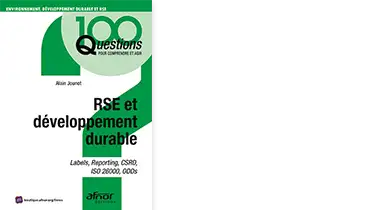
In 2017, equality between women and men was declared a major national cause of the five-year term. Here are four ways in which your company can contribute to this: applying the recommendations of the voluntary ISO 53800 standard of May 2024, increasing the skills of your teams responsible for the subject through training or IMPACT support, voluntarily obtaining the Professional Equality label and the mandatory calculation of the Equal Pay Index.
Building your approach with NF ISO 53800
Available in the AFNOR collection here, the voluntary standard NF ISO 53800 voluntary standard will help you deploy a gender equality approach in your organization, without leaving anything out. Published in May 2024, it is the fruit of an international effort initiated by France, which already had the AFNOR SPEC X30-020 guidedrawn up with public and private stakeholders.
The text begins with definitions. This is followed by “guidelines” that will enable you to draw up a roadmap with an exhaustive action plan. The appendices (15 pages) provide a series of practical examples.
The text provides help in complying with several of the United Nations Sustainable Development Goals (SDGs), in particular SDG 5, since 104 of the UN’s 246 indicators have gender-related targets(source OECD 2020). ISO 53800 tackles the subject of gender equality through the organization’s internal dimension, its activity and investments, its external relations, as well as its internal and external communication. It covers not only the professional sphere, but all aspects of the lives of girls and women. Important point: it is not certifiable.
Recognizing gender equality in the workplace with a label

Is your company implementing a gender equality program? It’s time to make the most of this commitment, with a voluntary label!
The Égalité professionnelle label attests to your exemplary commitment to improving gender equality. It can be awarded to companies of all sizes. The assessment covers concrete actions in favor of professional equality, human resources and management management, as well as support for parenthood in the workplace, for example.
Preventing discrimination, reducing pay gaps, respecting the boundary between private and professional life… This label is a sign of recognition for companies that integrate professional equality into their CSR actions.
Training and support to promote equality
Is your company, association, institution or local authority committed to promoting gender equality and in need of an in-house expert? You can become this expert yourself, through training. AFNOR Compétences offers two modules:

You can also request IMPACT support from an AFNOR Compétences coach who will come and support you internally with the aim of :
- Increase your organization’s attractiveness when recruiting by guaranteeing gender equality
- Retaining talent over time through an inclusive policy
- Define an objective equal treatment policy
- Get all teams on board and improve professional practices
What is the Gender Equality Index?
As of March 1, 2020, all companies with at least 50 employees must calculate and publish an annual gender equality index. This index must be published on the company’s website every year. Details of the indicators must also be communicated to the company’s Social and Economic Committee (CSE) and to the Direccte labor inspectorate.
This 100-point index is based on 5 main criteria (or 4 for companies with fewer than 250 employees):
- The gender pay gap
- The individual increase distribution gap
- Promotion distribution gap (for companies with more than 250 employees only)
- The number of employees returning from maternity leave with a raise
- Parity among the 10 highest earners
Is a company’s index below 75 points? Corrective measures are to be introduced, with the aim of reaching the 75-point mark within 3 years.
Our FAQ on gender equality
How can you promote your professional equality approach within your organization?
It can be a good idea to promote the company’s approach to equality and diversity, for example, to make it more attractive to new talent. Particularly if it goes beyond the legal minimum. AFNOR Certification offers you two labels: the Diversity label and the Equality label, as well as a combination of the two.
How do you calculate the professional equality index?
Since the Law for the Freedom to Choose One’s Professional Future of September 5, 2018, French companies have been subject to the obligation to calculate the gender professional equality index, every year, and publish it before March 1 of the following year. This index makes it possible to assess the pay gap between men and women, and find out what is being done to reduce it. Several criteria are used to calculate a score out of 100:
- Salary differential (40 points)
- Increase differential (20 points)
- Promotion gap (15 points)
- Percentage of employees who received a raise after returning from maternity leave (15 points)
- Number of employees of under-represented gender among the ten highest earners (10 points)
What are the professional inequalities?
Professional inequalities between men and women are grouped into 5 types:
- Pay inequality
- Unequal career opportunities
- Gender discrimination
- Inequalities linked to parenthood
- Inequalities linked to flexible working
More information :
Show your commitment to diversity in the workplace – AFNOR Group
What is professional equality in the workplace?
Equal opportunity refers to a working environment in which people are treated equally and fairly, whatever their gender, ethnic origin, religion or disability. Professional equality includes several components:
- Equal pay
- Equal opportunities
- Work-life balance
- Harassment prevention
- Diversity and inclusion
- Inclusive policies
More information :
Managing an equality, diversity and integrity initiative – AFNOR Group
